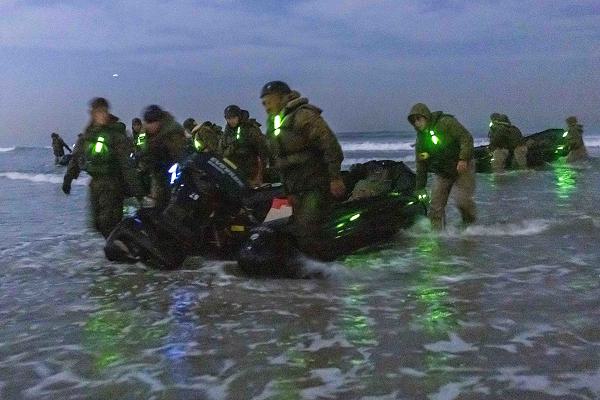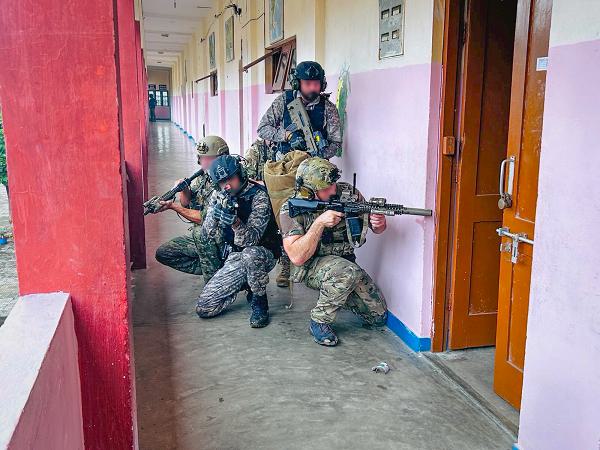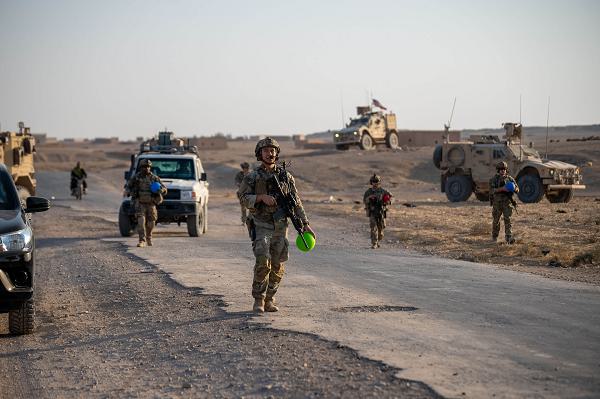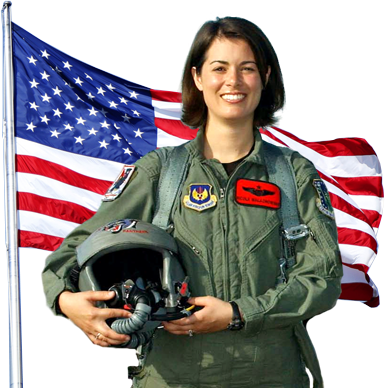- Details
- Hits: 1571

Fort Stewart, Georgia. (November 28, 2024): In this photo by Sergeant Anthony Ford, soldiers take cover as a Bangalore torpedo explodes just to their front. This famous device is credited with saving thousands of allied lives on D-Day. The Bangalore was originally designed by local farmers wanting to clear paths and heavy undergrowth. Along comes Captain R. L. McClintock of the Royal Engineers in 1912 who created a more powerful explosion and a whole new role for the Bangalore.
Soon, use of the “Bangalore” mine would sweep through the British Army and it quickly became the primary tool used by combat engineers. The device saved lives by allowing troops to clear obstacles that would otherwise require them to approach directly, possibly under fire. The mine originally looked something like a long chimney brush with an explosive charge attached and then several connected tubes added to the required length.
- Details
- Hits: 966

Coronado, California. (December 10, 2024): The Navy’s home of amphibious warfare looks every bit like an exotic oceanfront resort. Situated on 5,500 yards of Pacific Ocean beaches, you wouldn’t suspect this is the home of America’s premier Naval gladiators. In this photo by Corporal Kyle Chan, Marines drag a combat rubber raiding craft onshore during an infantry company small boat raid course. The Coronado facility is home to the Naval Special Warfare Command, Expeditionary Warfare Training Group, and the Navy's Sea-Air-Land (SEAL) Team.
This sprawling base is where the Marines practice their amphibious assault skills, particularly in deploying and maneuvering small boats. These smaller craft are used to insert Marines for various operations including executing raids or securing beachheads. To be successful, Marines must be able to manage these unruly crafts in heavy seas and under the most challenging conditions.
The beaches at Coronado are an ideal place to practice infiltrating and exfiltrating forces under realistic conditions. The Marines train in providing small-caliber gunfire support for fellow Marines going ashore and recovering the wounded. Other topics taught at Coronado include conducting coastal patrols, surveillance, interdiction, and search and rescue operations.
- Details
- Hits: 811

Fort Indiantown Gap, Pennsylvania. (December 8, 2024): How do you promote and retain highly capable senior NCOs whose knowledge and skills are vital to the Army? Why not give them a chance to become an “Officer by another means.” In this photo by Sergeant 1st Class Shane Smith, Sergent 1st Class Ratthiny Ly is promoted to the rank of Warrant Officer 1 with all the duties and privileges of that office.
WO1 Ly will join the roughly 26,000 warrant officers in today’s Army who serve as both technical experts and leaders who command units, aircraft, vessels, and armored vehicles. A warrant officer is a hybrid between enlisted personnel and commissioned officers.
- Details
- Hits: 865

Visakhapatnam, India. (December 2, 2024): Some of the best warfighters in the world mixed it up this week during a training exercise hosted by the Indian Navy. In this photo by Petty Officer 1st Class Alex Perlman (portions of which have been blurred for security reasons), U.S. Naval Special Warfare operators and Indian Marine Commando Force members conduct close quarters combat training during Malabar 2024 . This is the twenty fourth year of exercises involving the United States and India and they often include friendly allies.
This year, Japan and Australia are contributing their forces to the event. The Japanese are sending the destroyer JS Ariake and a contingent from the Japan Maritime Self-Defense Force. The Aussies are contributing the Navy frigate HMAS Stuart and a Royal Australian Air Force P-8A Poseidon maritime patrol aircraft. The Americans are adding a P-8 Poseidon aircraft assigned to guided-missile destroyer USS Deweya and the Indian hosts are contributing the destroyer INS Delhi as well as at least four other surface combatants and aircraft.
- Details
- Hits: 736

Philippine Sea. (November 30, 2024): In this photo by Petty 1st Class Ryre Arciaga,
Aviation Structural Mechanic 2nd Class Kristiana Tyler, from Broken Arrow, Oklahoma, clings to a giant MH-60R Sea Hawk helicopter while installing a tail fastener. Tyler is assigned to Maritime Strike Squadron 51 and currently serves aboard the guided-missile destroyer USS Preble. An Aviation Structural Mechanic (ASM) maintains all aircraft hydraulic power systems, wing airfoils and associated surfaces, and flight controls. It is exacting work, and the consequences of mistakes can be catastrophic.
There are two types of ASMs, Structural Hydraulics and Safety Equipment. The structural types concern themselves with the hydraulic system, landing gear, and the entire fuselage. The safety types are responsible for maintaining aircraft protection systems, including ejection seats, oxygen supply, and fire extinguishing systems. ASMs may be assigned to sea or shore duty anywhere in the world and may work in hangars on base or on aircraft carrier flight decks.
To become an ASM, a candidate must have a high school diploma or equivalent, complete eight weeks Basic Training, and 18 months’ of technical instruction at Pensacola, Florida. That is when school really begins. An ASM’s value increases dramatically with the type of high-speed, real-world experience gained in the service.
- Details
- Hits: 937

Al-Tanf, Syria. (December 5, 2024) In this photo by Staff Sergeant Emma Scearce, U.S. Soldiers provide toys and health care items to villagers during a security patrol in northeast Syria. There are roughly a thousand U.S. military personnel who are at greater risk of attack by various Islamic groups vying for power in Syria. American troops have been in Syria for the past ten years to prevent the resurgence of the Islamic State. The U.S. presence also supports Washington’s Kurdish allies and helps contain the influence of Iran and Russia in the country. It also makes it more difficult for Iran to move weapons into Lebanon to support its proxy, the Lebanese Hezbollah.
The Americans are based at Al-Tanf, an outpost in occupied territory fifteen miles from the Iraq/Jordanian border. The 13-year civil war reignited with surprising speed resulting in a total collapse of the country in less than one week. Syrian strongman Bashar al Assad’s allies abandoned him and he is reportedly taking refuge in Russia.
Leading the offensive is Hayat Tahrir al-Sham (HTS), Organization for the Liberation of Greater Syria, a former al-Qaeda affiliate. In 2012, the U.S. and several other nations designated the group a terrorist organization. Back then they were known as the al Qaeda Syrian branch. The group has recently renounced the Islamic State’s tactics to project a more moderate image.


